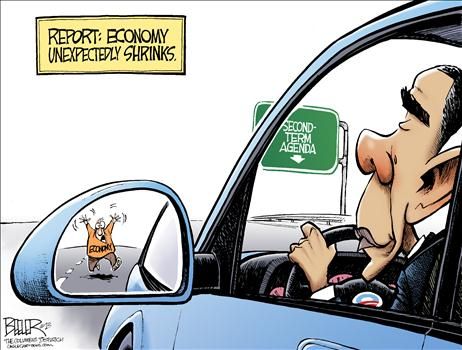
By John Merline
In the wake of
Wednesday's news that the economy contracted slightly in the last three months
of 2012, Senate Majority Leader Harry Reid laid the blame on budget cuts.
"The
economy was rejecting the austerity and brinksmanship," he said.
That theme —
that spending cuts are putting economic growth at risk — has been gaining
traction these days, particularly among those on the left.
Rep. Chris Van
Hollen, D-Md., said the GDP drop showed that pushing "big austerity
measures now will hurt the recovery."
Former Obama
economic adviser Jared Bernstein asserted U.S. policy has been based on
"austerity at (a) time when we need a fiscal push."
And the liberal
Center for American Progress complained that "fiscal austerity threatens
the U.S. economy."
On the surface,
it might look that way.
In its GDP
report, for example, the Bureau of Economic Analysis said government spending
dropped 6.6% in Q4. And unless Congress acts, more than $1 trillion in
automatic spending cuts will start to kick in as part of the so-called
sequester.
But dig a little
deeper, and there's little to back up all this austerity talk.
Spending: Up
According to
monthly spending data from the Treasury Dept., total federal
spending — which includes transfer payments and other federal outlays not
counted by the BEA — increased by $98 billion in Q4 compared with Q3. And
spending was up $31 billion when compared with Q4 2011.
For the entire
year, spending in 2012 was virtually unchanged from 2011, and was up $86
billion over 2010, a year when the government was still spending stimulus money
in earnest.
Plus, the
"fiscal cliff" deal worked out between President Obama and the
Republicans actually added almost $50 billion to planned spending in 2013, and
a total of $332 billion over the next decade, according to the Congressional
Budget Office.
Almost half of the
2013 increase will go to pay extended unemployment benefits, which Democrats
have long argued are highly stimulative.
Reid himself has
said that unemployment benefits "help our economy
because recipients spend the cash they receive on the things they need right
away."
In addition,
even if the "sequester" should go through, federal spending will
continue to climb.
No Real 'Cuts'
In fact, if nothing
else changes, spending in 2013 will be $3.6 trillion, an increase of nearly 2%
over 2012, according to data from the CBO. That's because the sequester's
"cuts" are actually just reductions in planned spending hikes.
Nor is the
federal government operating anything close to an austere budget when looked at
as a share of the economy. According to the CBO, spending this year will
account for 22.4% of GDP, a level reached only eight times since 1946 — four of
which occurred under Obama.
Plus, the
government keeps running massive deficits, which are also supposed to be
stimulative. Deficits topped $1 trillion in 2012 — for the fourth year in a row
— and are on track to reach that level again this year.
And the
government has already racked up $292.4 billion of deficits in just the first
three months of the 2013 fiscal year, which began last October, according to a
Treasury report.
Another way to
look at it is: Federal spending in 2012 was $121 billion higher than it would
have been had the government just been left on autopilot during Obama's entire
first term.
And it will be
$23 billion higher this year.
Nor has
austerity gripped state budgets, despite often repeated claims of
"draconian" state spending cuts. In fact, state "general
fund" spending climbed 3.4% last year and 3.5% the year before that, and
is expected to increase 2.2% this year, according to the National Association of State Budget Officers.
Total state
spending in 2012 was 12.5% higher than it was in 2008, NASBO data show.
No comments:
Post a Comment